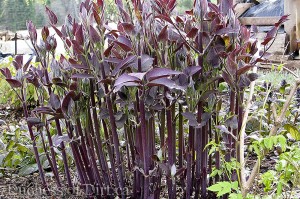 Clematis viticella ‘Polish Spirit’
Clematis viticella ‘Polish Spirit’
(KLEM-uh-tis vih-tih-CHELL-ah)
Family: Ranunculaceae
Common name: Clematis ‘Polish Spirit’
Zone: 4 – 9
Height: 15 – 20 ft (4.5 – 6 m)
Spread: 3 – 5 ft (0.9 – 1.5 m)
Aspect: full sun; partial shade
Soil: humus-rich; well-draining
Water: regular
Description: A vigorous growing, deciduous vine. Masses of 3 – 4 inch (7.5 – 10 cm) velvety, violet-blue flowers are set off by rich, dark green leaves appear in mid- to late-June straight through until a killing frost.
Special Notes: This cultivar of clematis was discovered in the monastery garden in Warsaw, Poland of the well-known clematis breeder, Brother Stefan Franczak, in 1984. Plant 2 year old seedlings 12 – 18 inches (30 – 45 cm) deep in a well-prepared hole amended with compost or well-aged manure and a complete fertilizer. Pruning Group C (or Group 3); flowers on new wood. Cut vine back to 12 inches (30 cm) in late winter or early spring. Best to strap vine if grown on a trellis and exposed to high winds. Very easy care; relatively pest and disease free, including clematis wilt. Propagation by internodal cuttings in spring.
 In our Zone 7a garden: This is one of our favourite clematis. Not only is it beautiful, but it is easy care and long blooming. The previous year’s spent growth on ‘Polish Spirit’ is cut back to a height of 8 – 10 inches (20 – 25 cm) in late winter. And that’s it, pretty much. You might have to tuck the odd rogue branch back into its trellis and you do have to water the vine on a fairly regular basis.
In our Zone 7a garden: This is one of our favourite clematis. Not only is it beautiful, but it is easy care and long blooming. The previous year’s spent growth on ‘Polish Spirit’ is cut back to a height of 8 – 10 inches (20 – 25 cm) in late winter. And that’s it, pretty much. You might have to tuck the odd rogue branch back into its trellis and you do have to water the vine on a fairly regular basis.
But be prepared to wait until about mid-July before the violet-blue flowers fully burst open and start their summer show. And what a show it is! The vine will be thickly covered in flowers straight through until the first frost which is typically sometime in October in our garden.
Adjusting the soil pH with ashes or a sprinkle of lime scratched in around the vine’s base and making sure it has regular water will ensure this clematis remains pest-free.
RHS Award of Garden Merit 1993; Great Plant Pick 2002
Posted on October 12, 2012; updated on January 29, 2025



